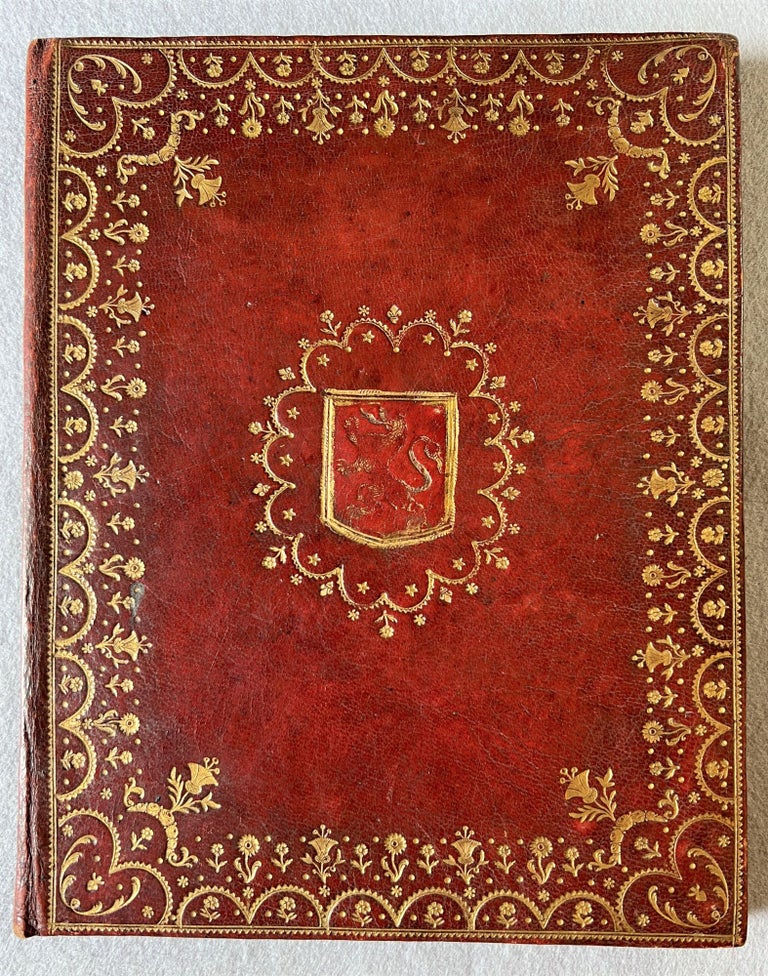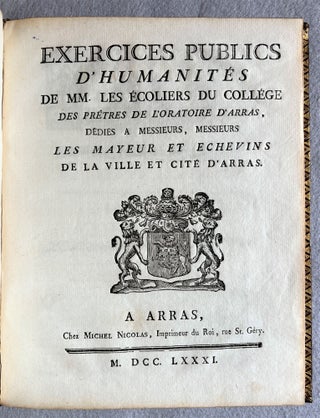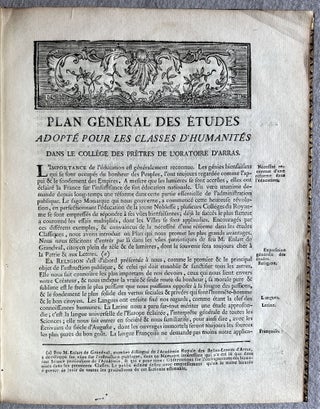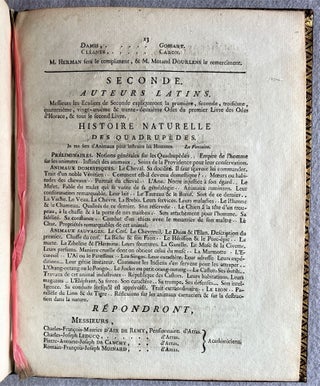Exercices publics d'humanités de MM. Les écoliers du collège des prêtres de l'oratoire d'Arras. Arras: Michel Nicolas, 1781.
4to (238 x 187 mm). 2 parts, separately titled and paginated. [21], 1 pages; 16 pages. Shoulder notes. Woodcut arms of Arras on title, woodcut headpieces and small tailpiece vignettes. Central section of the first title, containing the woodcut, removed, the two remaining portions of the leaf neatly mounted; first leaf with creased corner. 18th-century morocco, sides with wide gold-tooled border, a scalloped central medallion with small flower and star tools enclosing a later onlay with the arms of Arras within a roughly gold-tooled border, flat spine with horizontally gold-tooled title within a double gilt fillet border, blue silk liners, edges gilt (the binding was evidently created for another book and was adapted for this one at an early date). Provenance: MD, modern leather gilt bookplate.***
An unrecorded program of study for the students of the Collège des Oratoriens of Arras. A Jesuit college until the suppression of that order in 1762, the Arras collège had been founded in 1561, and still exists, now called the Lycée Robespierre, after its best-known alumnus. The Oratorian order, whose raison d’être was the education of future priests (and local social elites), had been the Jesuits’ main competitor, and its priests were hotly pursued to run schools once the Jesuits had left. The Arras collège was one of the lucky schools to succeed in bringing them in. There, starting in the 1770s, the Oratorians overhauled the curriculum and generally raised the level of the school, bringing into their instruction the “new ideas” and the sciences, in a program directly influenced by the Encyclopédie.
These pamphlets describe one aspect of the Oratorians’ innovative pedagogy: they decreed that all students be required to present their work in public, once per semester, along with a group of 8 professors (Académiciens). The reasoning behind this proposal (emulation is a stimulus, preparing for an event inspires students to work, and public speaking builds confidence) are explained in a 3-page introduction, which concludes with a list of all the subjects assigned to each grade in preparation for the presentations, for each of the two semesters. While Latin literature was a constant, the first semester was dedicated to History and Geography, and the second to Natural History. In order not to overtire or confuse the students, each presentation was to contain only two subjects, one being Latin. In the second semester, for example, the students of the Fifth class must be prepared to speak on pastoral poetry and the natural history of fish, those of the Fourth class on didactic poetry and the natural history of insects, and so on.
The two parts that follow this introduction contain the detailed curricula which each class had to study in preparation for these public events. Local citizens are exhorted to attend, and the pamphlets appear to have been printed as much for the use of the public as for the school (the dates and times of the presentations, extending over seven days in May and August, are provided at the end of each part). For the Second class, for example (the junior year), the students were to prepare a selection from the first book and all of the second book of Horace’s Odes, as well as the natural history of quadrupeds; a list of the animals and the relevant topics takes up two long paragraphs. The oldest students, in their last year, known as Rhétorique, were assigned, besides Cicero’s Pro Milone and the entire Ars poetica of Horace, the natural history of man. The paragraph describing this loaded subject is a sort of resume of 18th-century prejudice, with topics including the characteristics of various peoples and races, customs of native Americans, political institutions of the early (Precolumbian) Mexicans, and many questions about the propensities and habits of “les Sauvages.”
These rare programs, of which I locate no other copies, were lovingly bound together a few years later, probably by a former student, or perhaps by a professor or a parent, who adapted a luxurious binding from another, slightly thicker volume, adding the arms of Arras and the rather clumsy spine lettering.
On the history of the Arras college, see the website of the Lycée Robespierre. Item #4188
Price: $3,500.00




